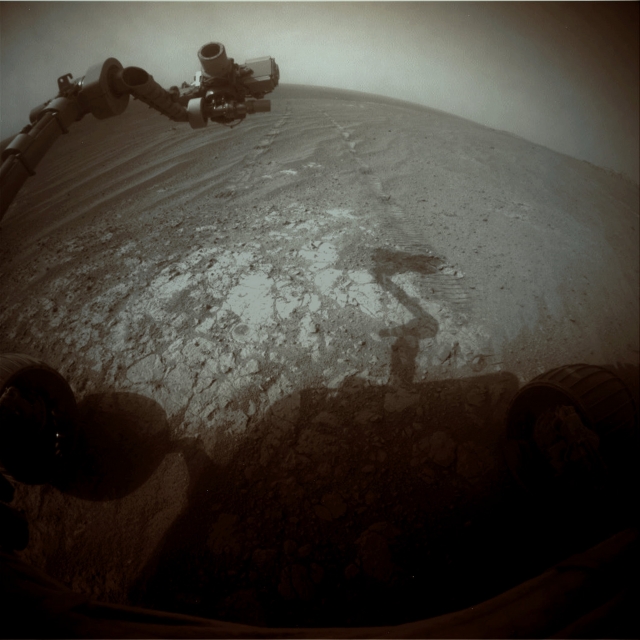
December 13, 2014
Credits: NASA/JPL-Caltech - MER Opportunity - Credits for the additional process. and color.: Dr Paolo C. Fienga/LXTT/IPF
|
The NASA - Mars Exploration Rover (MER) Opportunity is continuing its traverse Southward on the Western Rim of Endeavour Crater during the Martian Fall of 2014, stopping to investigate targets of scientific interest along the way. This view is from Opportunity's Front Hazard Avoidance Camera (or "Front Haz-Cam", for short) and it was obtained on November 26, 2014, during the 3854th Martian Day, or Sol, of the Rover's work on Mars. This Front Haz-Cam is mounted low on the Rover and has a Wide-Angle Lens. The scene includes Opportunity's Robotic Arm, also known as "RA, for short", or "Instrument Deployment Device," at the upper left (Sx) of the frame. Out of curiosity, some portions of the Pale bedrock exposed on the Ground in front of the Rover are within the RA's reach. Planetary Researchers used several instruments located on the RA to examine a target nicknamd "Calera", on this Patch of Bedrock. The Wheel Tracks in the scene are from the drive - in reverse - to this location: a drive of about 32,5 feet (such as approx. 9,906 meters) which took place on Sol 3846 (such as November, 18, 2014, on Earth). This picture (which is an Original b/w Image taken by the Front Haz-Cam located onboard the NASA - Mars Exploration Rover (MER) - "Opportunity" on November, 26, 2014, published on the NASA - Planetary Photojournal and identified by the ID n. PIA 19082) has been additionally processed, magnified in order to help the visibility of the Landscape's details, Gamma corrected and then colorized in Absolute Natural Colors (such as the colors that a normal - meaning "in the average" - human eye would actually perceive if someone were on the Surface of Mars, near the NASA - Mars Exploration Rover (MER) Opportunity, and then looked ahead, towards the Surface, Horizon and the Sky above Endeavour Crater), by using an original technique created - and, in time, dramatically improved - by the Lunar Explorer Italia Team. |
News visualized: 645 times

